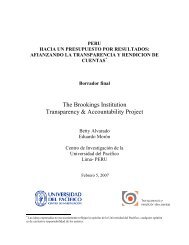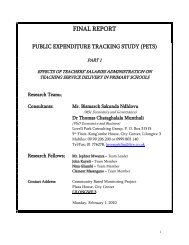Provider Purchasing and Contracting for Health Services_The Case
Provider Purchasing and Contracting for Health Services_The Case
Provider Purchasing and Contracting for Health Services_The Case
You also want an ePaper? Increase the reach of your titles
YUMPU automatically turns print PDFs into web optimized ePapers that Google loves.
Paying the providers<br />
<strong>Health</strong> care providers were funded through the SWAp mechanism. In addition, health centers<br />
<strong>and</strong> hospitals supplemented their income through cost sharing <strong>and</strong> cost-recovery user fees. 5<br />
Hospitals also received funding through the purchase of beds by lower level facilities that<br />
referred patients to them. According to the guidelines, the hospital boards negotiated with the<br />
district boards on how much of their grants the districts should allocate to the hospitals<br />
providing <strong>for</strong> the purchase of beds. <strong>The</strong> negotiations were limited within 20–40 percent of a<br />
board’s operations grant.<br />
Bypass fees were imposed on patients who self-referred. In cases where the patient did not<br />
pay the fees, the referral institution could claim the revenues arising from such from the<br />
respective District <strong>Health</strong> Management Team under the contractual agreement.<br />
Disbursement of funds<br />
Once the contracts were signed, the Ministry of <strong>Health</strong> released funds to the Central Board of<br />
<strong>Health</strong> on a monthly basis, while basket funds were released on a quarterly basis. In turn, the<br />
Central Board of <strong>Health</strong> released fund to district <strong>and</strong> hospital boards on a monthly basis in<br />
accordance with the contracts signed. Both the basket funds <strong>and</strong> government funds were<br />
supposed to be released at the same time; however, in practice, the releases occurred at<br />
different times.<br />
<strong>Contracting</strong> among public providers<br />
<strong>The</strong> three-tier referral system discussed earlier provided the framework <strong>for</strong> contracting<br />
among public health care providers with the decentralized units as implementing agents. As<br />
noted earlier, each level of care had a clearly articulated or defined package of health care <strong>for</strong><br />
the target population.<br />
First-level referral system: <strong>The</strong> district boards were fund holders responsible <strong>for</strong> providing<br />
primary health services as well as the first-level referral services. <strong>The</strong>y also served as<br />
gatekeepers in the purchasing <strong>and</strong> provider contracting system, by providing the entry point<br />
<strong>for</strong> the patient <strong>and</strong> determining the required services <strong>for</strong> attention <strong>and</strong> reference based on<br />
individual cases. For contractual purposes, they were authorized to purchase services on<br />
behalf of the catchment populations. <strong>Services</strong> at the district level could be purchased <strong>for</strong> a<br />
variety of reasons such as the following:<br />
• Insufficient capacity or supply in the respective District <strong>Health</strong> Board. This could be<br />
provided by another District <strong>Health</strong> Board.<br />
• Lack of a respective district facility, in which case a corresponding District <strong>Health</strong><br />
Board <strong>and</strong>/or secondary or tertiary facility, depending on different factors, could be<br />
contracted <strong>for</strong> specific services<br />
• Lack of expected services, in which case, <strong>for</strong> nonclinical services, other supplies<br />
could be contracted to provide the service<br />
5 Cost sharing is also referred to as low-cost sections of the providers. Patients meet a small proportion of the<br />
treatment costs. Cost recovery exists mostly in hospitals. Some sections of the hospital operate on private sector<br />
principles <strong>and</strong> charge full treatment costs. <strong>The</strong> services in the high-cost section are expected to be efficient with<br />
availability of medical personnel <strong>and</strong> drugs <strong>and</strong> supplied at all times.<br />
37
















